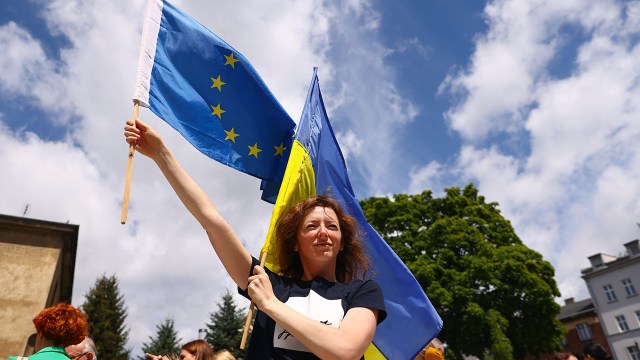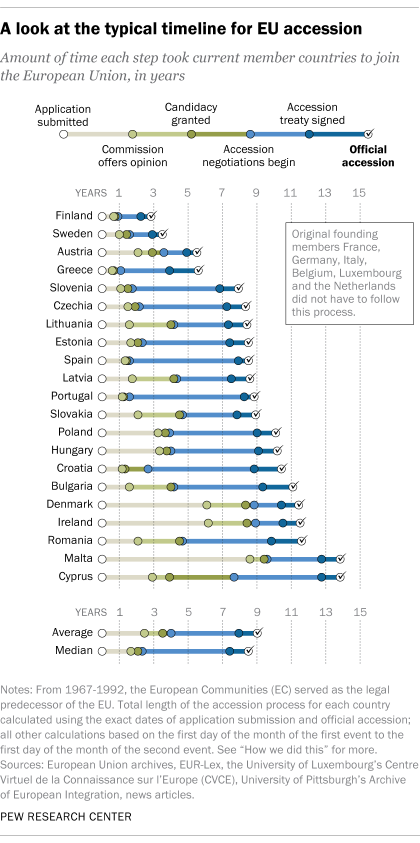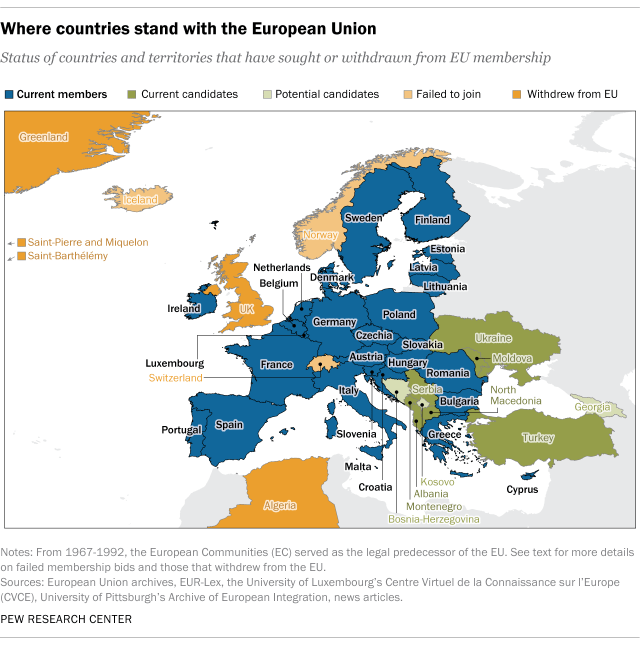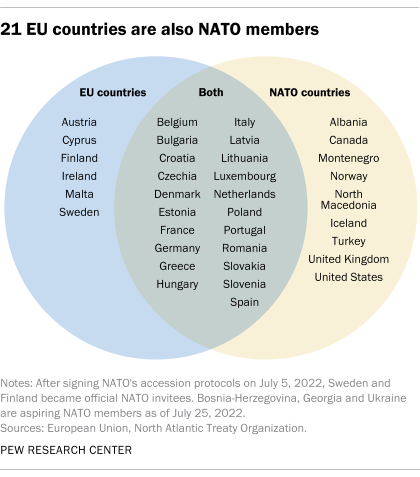
Ukraine and Moldova are officially on the path to membership in the European Union. The EU approved their applications in record time amid Russia’s invasion of Ukraine and concerns that Moldova might be targeted next. But joining the EU is a complicated process that can take years, and there’s no guarantee either country will ultimately win a seat at Europe’s biggest table.
With a possible expansion of the EU, here are answers to some common questions about the bloc, how countries can join it, how long each step typically takes and more.
This Pew Research Center analysis looks at the steps and typical timeline of joining the European Union, based on the accession processes of the EU’s 21 current member countries that underwent the accession process (the other six EU countries – Germany, France, Italy, the Netherlands, Belgium and Luxembourg – were original founding members that did not follow this process to join). It relied on news articles and EU archives, as well as primary source documents from EUR-Lex, the University of Luxembourg’s Centre Virtuel de la Connaissance sur l’Europe (CVCE) and the University of Pittsburgh’s Archive of European Integration.
The total length of the accession process for each country was calculated using the exact dates of application submission and official accession. All other calculations are based on the first day of the month of the first event to the first day of the month of the second event, except to calculate the time from application to candidacy for Ukraine and Moldova. If a country submitted multiple applications, the date of the first application submitted is used. The date of the Commission’s opinion is not necessarily the first opinion issued if an initial application was vetoed or the accession process was paused; instead, the date of the opinion for the eventual successful application is used. An applicant is awarded candidate status by unanimous approval by the European Council. In this analysis, candidacy dates were determined based on documents from EU Council summits. The date an accession treaty was signed differs from the date negotiations close, and from the date the treaty is ratified in the country’s national legislature.
What is the EU, and how is it set up?
The European Union is an international economic and political alliance of 27 member countries, 19 of which use the euro as their official currency. Its roots date back to 1952, when six countries founded the European Coal and Steel Community (ECSC) to boost economic growth and ease post-World War II tensions. By the mid-1960s, the ECSC merged with two other organizations and was renamed the European Communities (EC); it served as the legal predecessor to today’s European Union, which was officially born in 1993.
The European Union has seven institutions, three of which are directly involved in the process of membership expansion: the European Council, the European Commission and the European Parliament.
- The European Council is comprised of EU members’ heads of state or government, the Commission president and the Council president. The Council meets at summits to discuss EU legislation and sets the EU’s broader political agenda. It is also responsible for deciding whether to accept or reject EU membership applications.
- The Commission has representatives from each member country who propose new laws for the EU and monitor the implementation of existing laws. Commissioners are nominated by the Council and approved by the Parliament. When a country applies to join the EU, the Commission determines if it’s prepared to become a member; it recommends whether the Council should open negotiations, or if certain economic or governance reforms first need to be made. The Commission continues to monitor a country’s progress throughout the process of joining the EU.
- Members of the Parliament are directly elected by citizens of EU countries and represent their home countries’ interests in the bloc. The Parliament works with the Council of the EU (not to be confused with the separate but similarly named European Council) to adopt and amend legislative proposals from the Commission. It also debates and votes on annual reports tracking countries’ progress in integrating the EU’s rules into their own laws.
| Year | Development |
| 1951 | Germany, France, Italy, the Netherlands, Belgium and Luxembourg sign the Treaty of Paris, establishing the European Coal and Steel Community (ECSC) (Treaty enters into force in 1952) |
| 1957 | The six countries sign the two separate Treaties of Rome, creating the European Economic Community (EEC) and the European Atomic Energy Community (EAEC) (Treaties enter into force in 1958) |
| 1965 | Merger Treaty is signed, consolidating the ECSC, EEC, and EAEC into one organization, the European Communities (EC), now comprised of an administrative Commission and executive Council (Treaty enters into force in 1967) |
| 1973 | First enlargement: Denmark, Ireland and the United Kingdom join |
| 1974 | European Council created to facilitate discussions among government leaders |
| 1981 | Second Enlargement: Greece joins |
| 1986 | Third Enlargement: Spain and Portugal join |
| 1992 | The Maastricht Treaty is signed, creating the European Union, which acquires the European Communities as its principal institution. The European Council obtains a formal role in crafting political guidelines for the EU’s development (Treaty enters into force in 1993) |
| 1995 | Fourth Enlargement: Austria, Finland and Sweden join |
| 2004 | Fifth Enlargement: Czechia, Estonia, Cyprus, Latvia, Lithuania, Hungary, Malta, Poland, Slovakia and Slovenia join |
| 2007 | Bulgaria and Romania join. Also, Treaty of Lisbon is signed, clarifying the powers and procedures of the EU; the European Council officially becomes one of the seven EU institutions (Treaty enters into force in 2009) |
| 2013 | Croatia joins |
| 2020 | UK officially leaves the EU |
How do countries join the EU?
Any European country that agrees to promote the EU’s common values – respect for human dignity and human rights, freedom, democracy, equality and the rule of law – and meets certain conditions, referred to as the “Copenhagen criteria,” is eligible to apply for membership. Countries must have a functioning market economy, stable democratic institutions, and be able to implement EU laws and fulfil membership obligations. (Applicants from the Western Balkans, like Serbia and Albania, must meet additional benchmarks to join.)
The process of joining the EU, also called accession, has three main steps: candidacy, accession negotiations and treaty ratification.
Candidacy status is granted by the unanimous decision of the European Council – informed by the European Commission’s recommendation – to formally accept the country’s application. The Council and candidate country then must agree to a framework for accession negotiations. Candidate countries also receive financial and technical assistance throughout the accession process. (The 2021-27 EU budget for pre-accession assistance is 14.162 billion euros.)
Accession negotiations commence, as the candidate country adapts its national laws to align with the EU’s rules, called the acquis. Negotiations formally conclude once each of the 35 acquis chapters (which focus on topics like taxation, the environment and defense policy) are unanimously closed.
An accession treaty is signed by the candidate country and the European Union (with the consent of the Council, Commission and Parliament) and later ratified by the candidate and each EU country, when it becomes binding. The country is henceforth deemed an “acceding country” until the official accession date, when it becomes a full EU member.
How long does joining the EU typically take?

On average, it’s taken about nine years for each of the 21 current members that underwent the accession process to join the EU. (The six other current EU countries were original founding members.) The timeline varies, however, depending on national and global politics and on how much a country needs to reform its own laws to meet the EU’s standards. For nine countries, the complete accession process took 10 or more years; Cyprus and Malta each took almost 14 years to officially join, the longest of any current member countries.
Just reaching candidacy status can take several years. Among the current EU members, it took an average of roughly 3.5 years from the time a country submitted a formal application to the time the European Council approved its candidacy. Ukraine’s and Moldova’s applications were approved about 11 times faster than the average EU member, taking almost four months. (Ukraine submitted its application on Feb. 28, 2022, and Moldova applied on March 3; both countries were granted candidacy status on June 23.) The next quickest was Greece, which rose to candidacy in about eight months. Malta (9.4 years) and Ireland (8.4 years) took the longest to achieve candidacy.
Which step takes the longest?
The negotiation phase of joining the EU is by far the longest. Among the current EU members, the time between the launch of negotiations and the signing of an accession treaty has taken an average of about four years – accounting for roughly half of the average duration of the accession process.
Negotiations took five or more years for 11 of the 21 current EU countries that went through the accession process. Portugal’s negotiations took the longest (6.7 years), but Spain (6.3 years) and Croatia (6.2 years) were close behind. Negotiations for Austria, Finland and Sweden were the quickest, lasting only 1.3 years.
Which was the most recent country to join the EU?
Croatia was the last to join the bloc in 2013, a decade after it first submitted its application.
Which countries are currently trying to join the EU?
Today, there are five other current candidate countries besides Ukraine and Moldova: Albania, North Macedonia, Montenegro, Serbia and Turkey. Turkey started negotiations in October 2005, but talks have been effectively frozen since June 2018, when the European Council expressed concern over what it called “backsliding on the rule of law and on fundamental rights including the freedom of expression” in the country. Montenegro and Serbia began negotiations in 2012 and 2014, respectively. The EU opened talks with Albania and North Macedonia in mid-July, after Bulgaria lifted its long-standing veto that had blocked negotiations, offering hope for the two aspiring members’ future accession.

How common is it for countries to leave the EU, as the United Kingdom officially did in 2020?
While Brexit might be the most well-known EU departure, it’s not the only one in history. Greenland, a limited self-governing Danish territory, originally joined in 1973 as an integrated part of Denmark (but not a member state). It withdrew from the EU, then called the European Communities, in 1985 following a referendum in February 1982. Today, it retains a special association with the organization as one of the EU’s Overseas Countries and Territories. Algeria, a former French colony, and two other self-governing overseas collectivities of France (Saint-Barthélémy and Saint-Pierre and Miquelon) followed similar paths.
Other countries failed to garner enough public support to join the EU in the first place. Norway signed a treaty of accession on Jan. 22, 1972, nearly 10 years after it submitted its first EU (then-EC) application. But it soon abandoned its membership bid after its citizens voted against joining in a September 1972 referendum. Switzerland applied for membership in 1992, but its application remained dormant for years following unfavorable referendum results; the country officially withdrew its bid in June 2016.
National politics played a role in other failed candidacies. Iceland applied for EU membership in July 2009 but halted accession negotiations in May 2013 when government control shifted hands. Unable to reach an agreement on fishing quotas – fishing being one of the country’s key industries – Iceland officially withdrew its application in March 2015.
Does the EU have any rules in place in the event that a member country is attacked militarily, as Ukraine recently was by Russia?
Since 2009, EU countries have been bound by a mutual defense clause to aid “by all the means in their power” fellow members that are subjected to armed aggression. Assistance is not limited to direct military support, so countries with neutrality policies can still participate. The clause has only been invoked once – to support France following the Nov. 13, 2015, terrorist attack in Paris.

Most EU members (21 out of 27) are also part of the North Atlantic Treaty Organization (NATO), an international military alliance with its own collective defense provisions.
While the EU is primarily an economic and political alliance, it has signaled moves to strengthen its defense capabilities. The European Commission recently proposed creating a Defense Joint Procurement Task Force to coordinate members’ military spending in response to Russia’s invasion of Ukraine.
